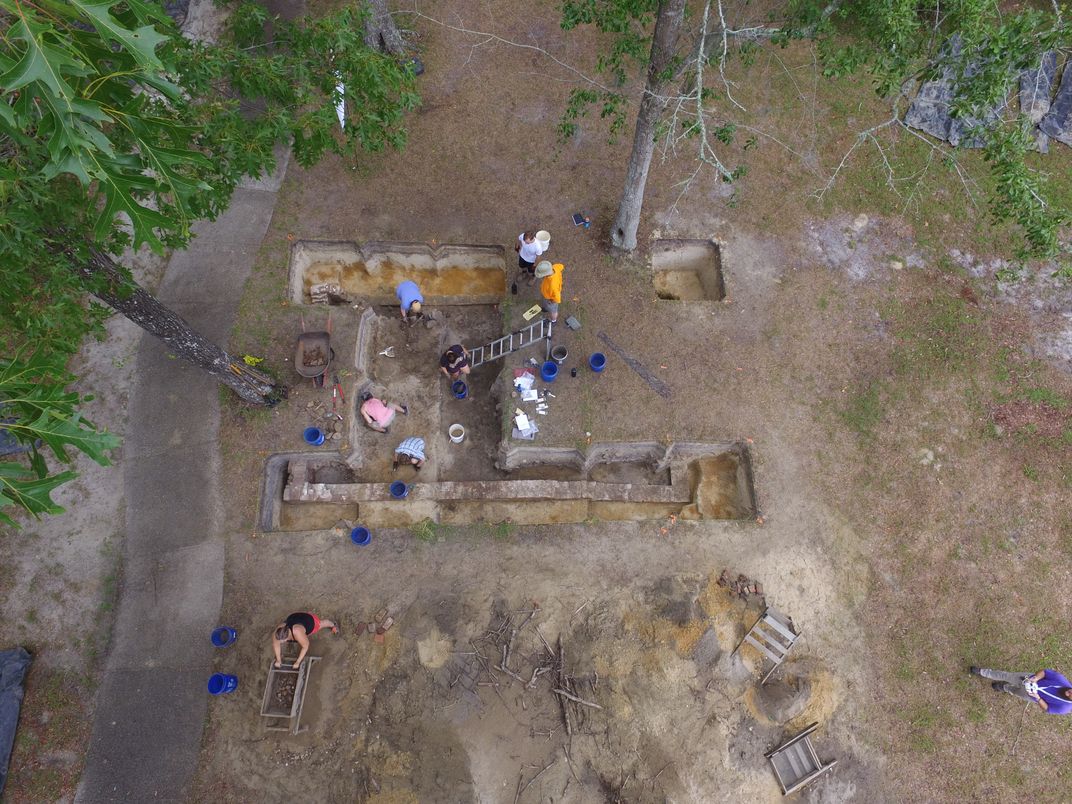‘Seditious’ Pressed Glass Jewel Found in 18th-Century North Carolina Tavern
The bead is imprinted with ‘Wilkes and Liberty 45,’ a code for those who opposed the policies of George III
In 1776, British troops razed the town of Brunswick, an important pre-Revolutionary port on North Carolina's Cape Fear River. For decades, archaeologists have combed through that site, looking for clues about life in the colonial era. Last year, East Carolina University doctoral student Matt Harrup found an intriguing one: using ground-penetrating radar, he identified the remains of a small tavern there that appears to have burned down a decade before the redcoats came ashore. Now, digging at the 400-square-foot site has turned up a pressed jewel. The find, the size of a pea, confirms Brunswick's reputation as a hotbed of sedition.
The artifact was covered in dirt when it was first identified during a recent dig. When it was cleaned, however, it revealed itself to be a small pressed glass jewel, one that had fallen out of cufflinks, parts of which were also identified at the site, Mark Price at the Charlotte Observer reports. Etched on the glass was the phrase “Wilkes and Liberty 45,” a secret message used in the 1760s to express opposition to British rule.
“That was a rallying cry for those in opposition of King George III,” says Charles Ewen, director of the Phelps Archaeology Laboratory at East Carolina University. Wilkes, he explains, was a reference to John Wilkes, a member of Parliament and political agitator who was idolized by many American patriots. Among other things, Wilkes is remembered for starting a publication called The North Briton—more or less an early tabloid—which attacked the Earl of Bute, the British prime minister at the time. But issue 45 of the publication, released in 1763, went a step further, criticizing George III directly instead of attacking his appointees, as was traditional.
Wilkes and 49 others were charged with sedition and treason and arrested under a general warrant. Wilkes escaped charges by claiming immunity as a member of Parliament. The others in the case turned the tables and sued the government over the legality of the general warrant and also won. Historian and Wilkes biographer Arthur Cash referred to the ruling as “a momentous shift in the locus of power in government."
Soon enough, “Wilkes and Liberty!” became a rallying cry for anti-government activists and the number 45 became a symbol of radical politics, notably among American colonists chafing under British rule, who followed Wilkes' many exploits closely in the papers.
Ewen tells Price that similar cufflinks with the phrase have been found in England, but this is the first time the seditious jewelry has been found in North Carolina. “I think of it in the same way as secretive Christians were wearing the fish symbol to identify each other,” Ewen says. “Maybe it was something under the radar. They weren’t outright denouncing the government, but maybe wearing these cufflinks let you know who was on your side.”
The cufflink jewel will likely go on display in the state historical museum.
The tavern, which fronts the Cape Fear River, was probably too small to have served as a major gathering place for patriots, or have been a brothel, as some have speculated. According to a press release, land records suggest that the tavern was built in the mid-1730s to early 1740s. A 1769 map of Brunswick Town created by French cartographer Claude Joseph Sauthier does not include the structure, but an Irish halfpenny found inside dates to 1766, which offers a rough timeframe for when it would have burned.
Besides the jewel and a pair of cufflinks, researchers digging in May and June uncovered nails, pipes, drinking vessels, Delft china, parts of a pocket watch and many other items preserved in the structure.
Ewen tells Ben Steelman at StarNews that only about 25 percent of the town has been excavated so far. “We don’t know everything about Brunswick Town,” he says. “This building wasn’t even on the map. What else of importance was gone by the time Sauthier got here?”
/https://tf-cmsv2-smithsonianmag-media.s3.amazonaws.com/filer/51/20/512094f6-591a-405a-b941-9fbcc6752e6d/wilkes_cufflink.jpg)

